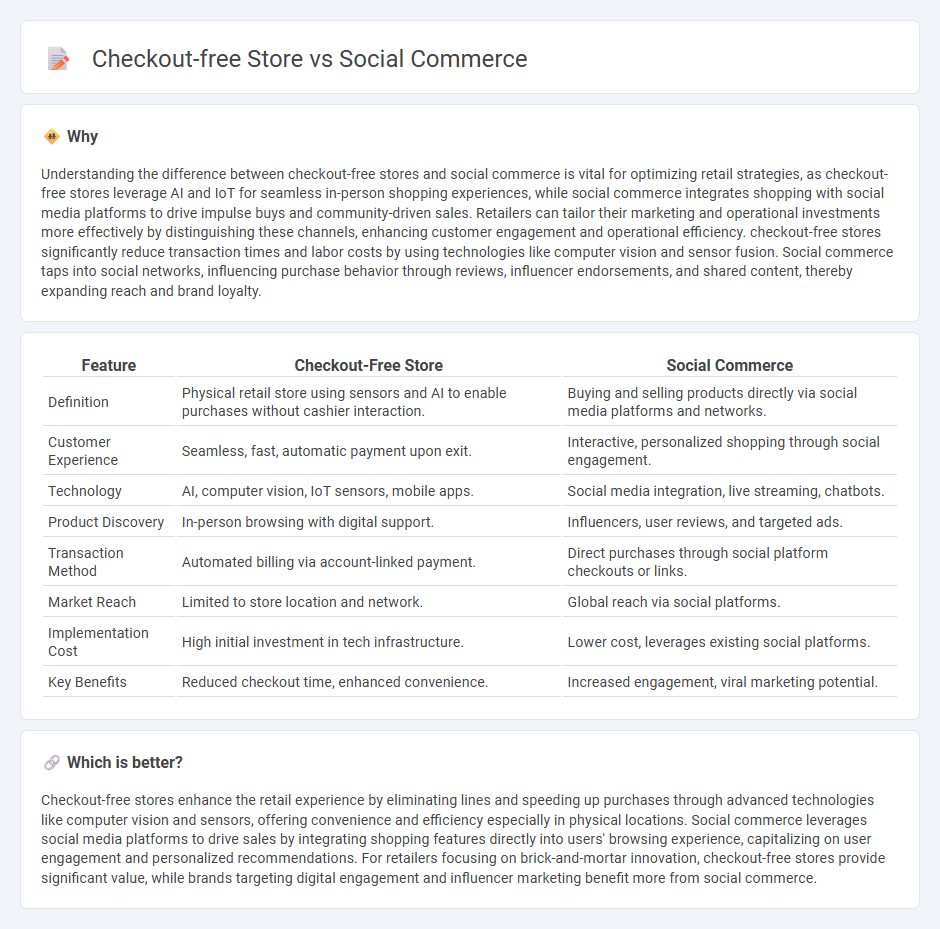
Checkout-free stores eliminate traditional payment lines by leveraging advanced technologies like RFID, computer vision, and AI to enable seamless, automated purchasing experiences. Social commerce integrates e-commerce capabilities directly within social media platforms, allowing users to discover, interact with, and buy products without leaving their favorite apps. Explore the evolving landscape of retail innovation by diving deeper into checkout-free stores and social commerce trends.
Why it is important
Understanding the difference between checkout-free stores and social commerce is vital for optimizing retail strategies, as checkout-free stores leverage AI and IoT for seamless in-person shopping experiences, while social commerce integrates shopping with social media platforms to drive impulse buys and community-driven sales. Retailers can tailor their marketing and operational investments more effectively by distinguishing these channels, enhancing customer engagement and operational efficiency. checkout-free stores significantly reduce transaction times and labor costs by using technologies like computer vision and sensor fusion. Social commerce taps into social networks, influencing purchase behavior through reviews, influencer endorsements, and shared content, thereby expanding reach and brand loyalty.
Comparison Table
| Feature | Checkout-Free Store | Social Commerce |
|---|---|---|
| Definition | Physical retail store using sensors and AI to enable purchases without cashier interaction. | Buying and selling products directly via social media platforms and networks. |
| Customer Experience | Seamless, fast, automatic payment upon exit. | Interactive, personalized shopping through social engagement. |
| Technology | AI, computer vision, IoT sensors, mobile apps. | Social media integration, live streaming, chatbots. |
| Product Discovery | In-person browsing with digital support. | Influencers, user reviews, and targeted ads. |
| Transaction Method | Automated billing via account-linked payment. | Direct purchases through social platform checkouts or links. |
| Market Reach | Limited to store location and network. | Global reach via social platforms. |
| Implementation Cost | High initial investment in tech infrastructure. | Lower cost, leverages existing social platforms. |
| Key Benefits | Reduced checkout time, enhanced convenience. | Increased engagement, viral marketing potential. |
Which is better?
Checkout-free stores enhance the retail experience by eliminating lines and speeding up purchases through advanced technologies like computer vision and sensors, offering convenience and efficiency especially in physical locations. Social commerce leverages social media platforms to drive sales by integrating shopping features directly into users' browsing experience, capitalizing on user engagement and personalized recommendations. For retailers focusing on brick-and-mortar innovation, checkout-free stores provide significant value, while brands targeting digital engagement and influencer marketing benefit more from social commerce.
Connection
Checkout-free stores leverage advanced technologies like computer vision and AI to streamline the retail experience, enabling seamless transactions without traditional checkout lines. Social commerce integrates e-commerce features directly into social media platforms, driving impulse purchases through influencer marketing and user engagement. The connection lies in how both innovations optimize the customer journey by reducing friction--checkout-free stores through physical convenience and social commerce through digital immediacy--enhancing overall retail efficiency and consumer satisfaction.
Key Terms
User Engagement (Social Commerce)
Social commerce leverages interactive features like live streaming, user reviews, and social sharing to boost user engagement and foster community-driven shopping experiences. Checkout-free stores utilize seamless technology such as RFID, computer vision, and sensor fusion to enhance convenience by eliminating traditional checkout lines. Discover how integrating these innovations can transform customer interaction and retention.
Automated Payment (Checkout-free Store)
Automated payment in checkout-free stores leverages advanced technologies like RFID, computer vision, and AI to enable seamless, contactless transactions, eliminating the need for traditional checkout lines. This innovation enhances customer convenience by allowing shoppers to pick items and automatically complete payments upon exit, reducing wait times and improving operational efficiency. Explore how automated payments transform retail experiences and drive the future of shopping convenience.
Mobile Integration
Social commerce leverages mobile integration by enabling seamless shopping experiences within social media apps, using in-app purchases, personalized recommendations, and social sharing to boost engagement and conversion rates. Checkout-free stores rely on mobile technologies such as QR codes, RFID, and AI-powered cameras to allow customers to scan or detect items, facilitating instant payment and eliminating the need for traditional checkout lines. Explore how these mobile innovations transform retail landscapes and enhance customer convenience.
Source and External Links
Social commerce - Social commerce is the use of social networks to conduct e-commerce transactions wholly within social media platforms, from browsing products to checkout without leaving the site.
What is social commerce? - Social commerce leverages social media apps like Facebook, TikTok, and Instagram to enable direct sales through native features, using data and personalized marketing to shorten the customer journey and build relationships.
What Is Social Commerce? Tips and Trends - Social commerce provides convenient, personalized shopping experiences on social media, helping brands expand reach, reduce sales cycles, and connect with customers using influencer marketing and omni-channel strategies.
 dowidth.com
dowidth.com